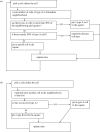Cellular automata and integrodifferential equation models for cell renewal in mosaic tissues
- PMID: 20375040
- PMCID: PMC2988252
- DOI: 10.1098/rsif.2010.0071
Cellular automata and integrodifferential equation models for cell renewal in mosaic tissues
Abstract
Mosaic tissues are composed of two or more genetically distinct cell types. They occur naturally, and are also a useful experimental method for exploring tissue growth and maintenance. By marking the different cell types, one can study the patterns formed by proliferation, renewal and migration. Here, we present mathematical modelling suggesting that small changes in the type of interaction that cells have with their local cellular environment can lead to very different outcomes for the composition of mosaics. In cell renewal, proliferation of each cell type may depend linearly or nonlinearly on the local proportion of cells of that type, and these two possibilities produce very different patterns. We study two variations of a cellular automaton model based on simple rules for renewal. We then propose an integrodifferential equation model, and again consider two different forms of cellular interaction. The results of the continuous and cellular automata models are qualitatively the same, and we observe that changes in local environment interaction affect the dynamics for both. Furthermore, we demonstrate that the models reproduce some of the patterns seen in actual mosaic tissues. In particular, our results suggest that the differing patterns seen in organ parenchymas may be driven purely by the process of cell replacement under different interaction scenarios.
Figures










Similar articles
-
Extracting cellular automaton rules from physical Langevin equation models for single and collective cell migration.J Math Biol. 2017 Nov;75(5):1075-1100. doi: 10.1007/s00285-017-1106-9. Epub 2017 Feb 27. J Math Biol. 2017. PMID: 28243720
-
Analysis of mouse eye development with chimeras and mosaics.Int J Dev Biol. 2004;48(8-9):793-804. doi: 10.1387/ijdb.041885jc. Int J Dev Biol. 2004. PMID: 15558472 Review.
-
Three dimensional visualization and fractal analysis of mosaic patches in rat chimeras: cell assortment in liver, adrenal cortex and cornea.PLoS One. 2012;7(2):e31609. doi: 10.1371/journal.pone.0031609. Epub 2012 Feb 7. PLoS One. 2012. PMID: 22347498 Free PMC article.
-
Modeling of mosaic patterns in chimeric liver and adrenal cortex: algorithmic organogenesis?FASEB J. 2000 Apr;14(5):823-7. doi: 10.1096/fasebj.14.5.823. FASEB J. 2000. PMID: 10744639
-
The role of tangential dispersion in retinal mosaic formation.Prog Retin Eye Res. 2002 Mar;21(2):153-68. doi: 10.1016/s1350-9462(01)00024-6. Prog Retin Eye Res. 2002. PMID: 12062533 Review.
Cited by
-
BIO-LGCA: A cellular automaton modelling class for analysing collective cell migration.PLoS Comput Biol. 2021 Jun 15;17(6):e1009066. doi: 10.1371/journal.pcbi.1009066. eCollection 2021 Jun. PLoS Comput Biol. 2021. PMID: 34129639 Free PMC article.
-
Models of collective cell behaviour with crowding effects: comparing lattice-based and lattice-free approaches.J R Soc Interface. 2012 Nov 7;9(76):2983-96. doi: 10.1098/rsif.2012.0319. Epub 2012 Jun 13. J R Soc Interface. 2012. PMID: 22696488 Free PMC article.
-
How much information can be obtained from tracking the position of the leading edge in a scratch assay?J R Soc Interface. 2014 Aug 6;11(97):20140325. doi: 10.1098/rsif.2014.0325. J R Soc Interface. 2014. PMID: 24850906 Free PMC article.
-
Learning spatio-temporal patterns with Neural Cellular Automata.PLoS Comput Biol. 2024 Apr 26;20(4):e1011589. doi: 10.1371/journal.pcbi.1011589. eCollection 2024 Apr. PLoS Comput Biol. 2024. PMID: 38669297 Free PMC article.
References
-
- Anderson A. R. A., Chaplain M. A. J., Rejniak K. A. 2007. Single-cell-based models in biology and medicine. New York, NY: Springer.
-
- Cox J. T., Durrett R. 1991. Nonlinear Voter Models. In Random walks, Brownian motion, and interacting particle systems (eds Durrett R., Kesten H.), pp 189–202. Boston, MA: Birkhäuser.
Publication types
MeSH terms
Grants and funding
LinkOut - more resources
Full Text Sources

